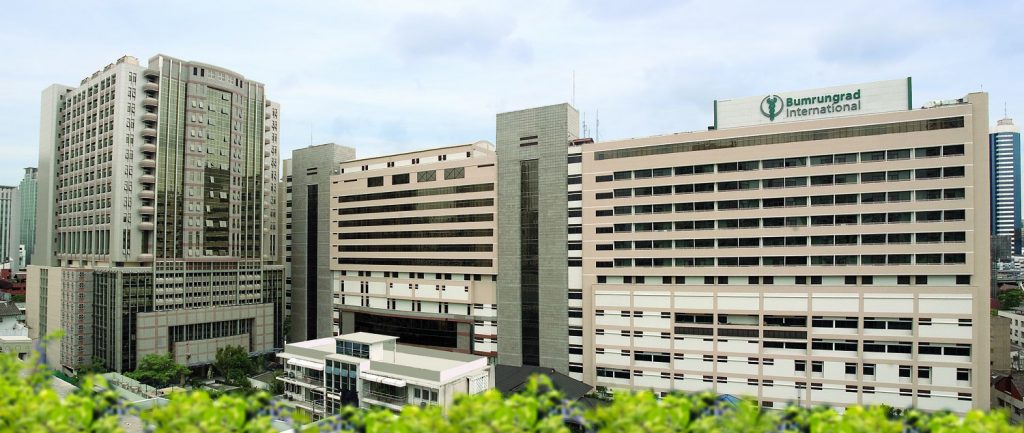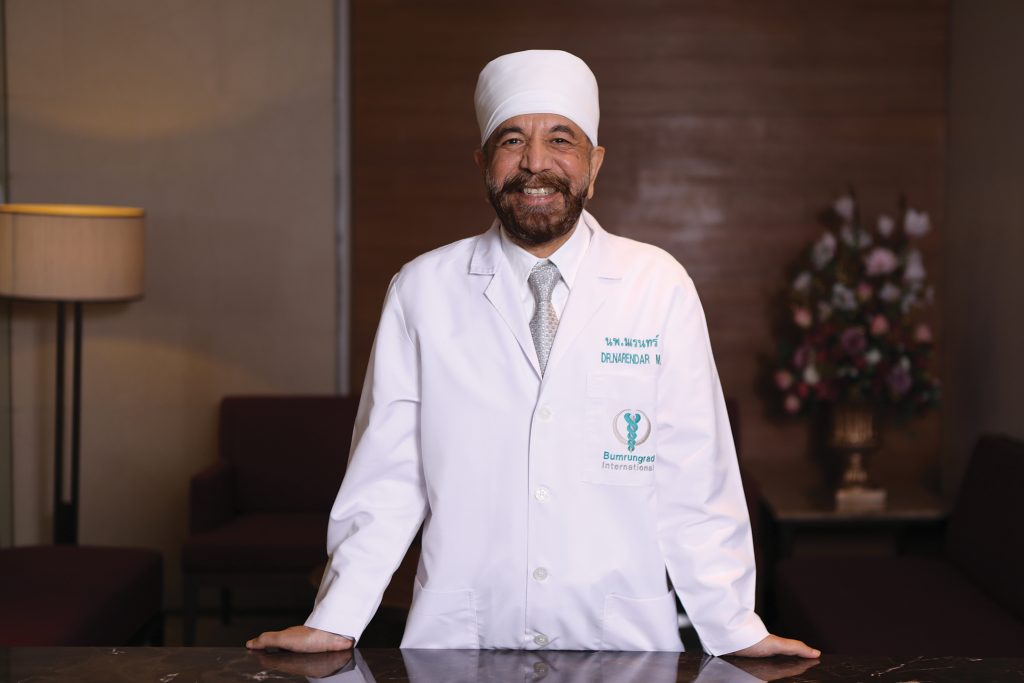How he’s put his whole heart into 35 years of practice at Bumrungrad International Hospital.
By Aiden Jewelle Gonzales
Walking into Bumrungrad International Hospital’s elegant lobby, with all the comforts, cutting-edge technology, and experienced personnel that anyone can desire in their health care provider of choice, it’s hard to imagine that it was once a neophyte in Thailand’s renowned medical scene. However, that’s exactly what it was when Dr. Narendar Malhotra joined the institution as a cardiologist and internist. “It was only 2-3 years old,” he tells me, “and back then there were very few private hospitals in Thailand. But from the beginning, Bumrungrad has been a very professionally-managed institute, and everyone earns due respect, whether they’re a nurse’s aid, a nurse, or a doctor.”
With all the gravitas that his 35 years in the hospital holds, as well as his years of experience in the medical field in Thailand, Australia and the UK, it’s clear that Dr. Narendar himself is afforded a large proportion of that respect from everyone around him, but he does not let that take away from the core of his passion for medicine. “I love to talk to people, to patients; learn from them, from their lifestyles, and their experiences. It’s one of the things I really enjoy about my job,” hesays. “The medical field is my spiritual guide. I can talk to patients for half an hour and I love it; I don’t have timings for them. I always love to take my time with them, and look into their eyes. That human element is one of the most essential parts of practicing medicine.”
However, the medical field was not always the most obvious choice for Dr. Narendar growing up. Although his family has been in Thailand for generations, he studied in India before deciding to pursue medicine, despite a thriving family business.
“I wanted to be very independent, and the medical field provided that,” he recalls. “I love medicine, and luckily, I had good scores in the Sciences. I started with internal medicine, and I chose to later specialise in cardiology because I enjoyed the challenge of learning new and interesting procedures.” Indeed, after choosing to do his elective training at some of Thailand’s top medical institutions during during his residency in internal medicine at Phramongkutklao Hospital, and studying his specialisation at the University of London, Dr. Narendar went to Adelaide, Australia, in the 1980s to study then-avant-gardecardiology techniques such as interventions and angioplasty ballooning.
Despite his international pursuits, however, he chose to come back home to Thailand, working first at Mission Hospital and eventually joining Bumrungrad almost 35 years ago. When asked for his reasons, he waxes eloquent on Thailand’s medical industry in general, and Bumrungrad’s unique selling points in particular. “Thai hospitality is known throughout the world, but what people don’t realise is that hospitality includes how you take care of patients,” he says, referencing the word’s shared etymological origin with ‘hospital.’
“It’s not just injecting them with medicine or putting tablets in their mouths. You need to cater to them as a human being, and to do that, you need the skills, which the people here all have. On top of that, Bumrungrad polishes all of us by providing the staff with continuous training, so you have good arms and hands to support you.”
When I point out that it’s apparent that Bumrungrad’s world- class reputation is deserved, he explains that a good health care provider should see patients as a human being on top of just being a patient. “As a person,” he tells me, “you want somewhere to feel secure, you want to feel that the institution is looking out for you. You want to make sure they’re guiding you from the beginning, even if someone isn’t unwell and just want preventative health. Another important aspect is that people want accurate information. Is the disease genetic? Viral? A result of lifestyle? Here we make sure to be candid and take care of our patients like they’re our family members.”
An example he gives me is the case of people from his own community. He corroborates that statistically, Indians and other South Asians are more susceptible to heart disease and diabetes than other ethnicities, regardless of where they live. “The question is,” he poses to me, “is it genetic, or is it our lifestyle? The South Asian diet is very rich in fats and high carbohydrates, so you need to balance it, and a lot people in the north and south of India are vegetarians, so they consume a lot of carbohydrates. It’s not a balanced diet.”
I posit that people from these communities must be more comfortable receiving advice from someone in their own community, and he agrees: “we have a shared culture, and they feel like I know what I’m talking about. I can tell them, late night wedding events where after-parties start at midnight and people eat at 3am aren’t conducive to good heart health, and they know that I’m an authority because I myself know what those parties are like.
When I ask him how he encourages those lifestyle changes, he tells me, “you can’t tell people, ‘don’t eat 10 things’ you have to slowly motivate them and let them prove the scientific data. You can say, you reduced eating this, and now your cholesterol is better. When they see the empirical data, they develop faith in you.”
When it comes to regular health check-ups, however, he tells me that a patient with no strong family history and who is physically fit doesn’t need frequent checks. However, an initial screening is important to determine your risk factors. “Heart disease doesn’t mean that every time you’ll have symptoms. Sometimes you have or you won’t know it’s there. If your screening shows no risk factors, then you can go every two to three years,” Dr. Narendar advises. “Don’t assume that just because you’re exercising, you’re healthy. This craze of building muscles without a clear goal why can be quite dangerous. Health and competing for good muscles is a different thing. It’s important to ask before you start an exercise plan, how healthy are you? Do you need this aggressive exercise plan or not? Basic evaluation is very important.”
He informs me, however, that the COVID-19 pandemic has compounded the risk of vascular diseases in the general public, both because of increased stress levels, and the ‘work from home,’ sedentary lifestyle. “Stress often leads to hypertension, because it produces a lot of chemicals in your body and makes your circulation poor. That’s why despite the pandemic, we all need to try maintain a healthy lifestyle, for both our physical and mental health.”
As for final advice to his community, Dr. Narendar tells them to love themselves, although, he says in gentle warning, it doesn’t mean feeding themselves everything. “Please check with a medical professional,” he pleads. “With the advent of the internet, many consider themselves a doctor, and diagnose themselves through the internet. They decide that they don’t need to go to the hospital, which is wrong. There’s no standard formula for everybody.”
A/N: Masala would like to apologise for the fact that an original version of the article had some factual inaccuracies. These have since been amended.








